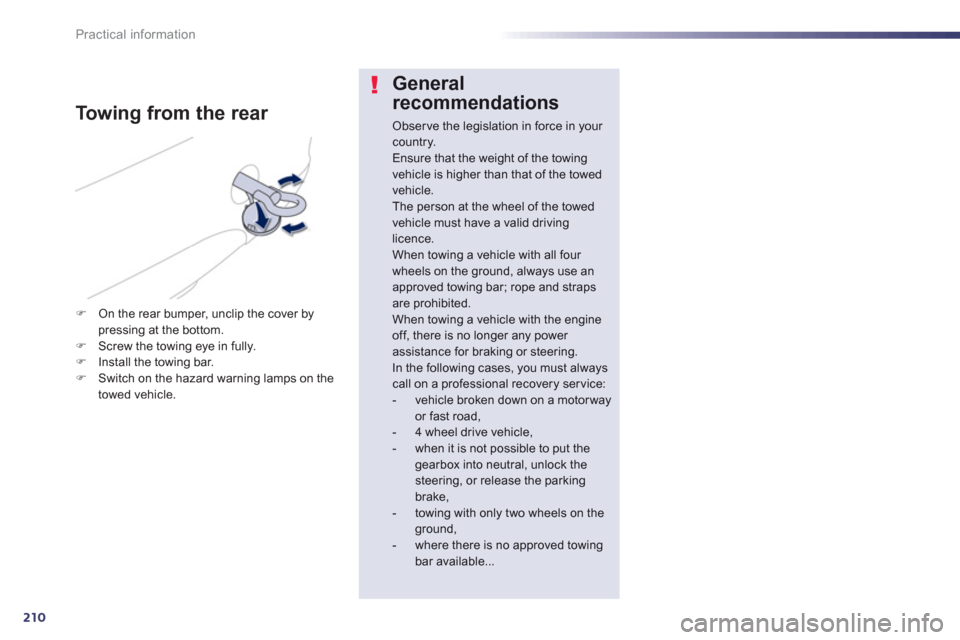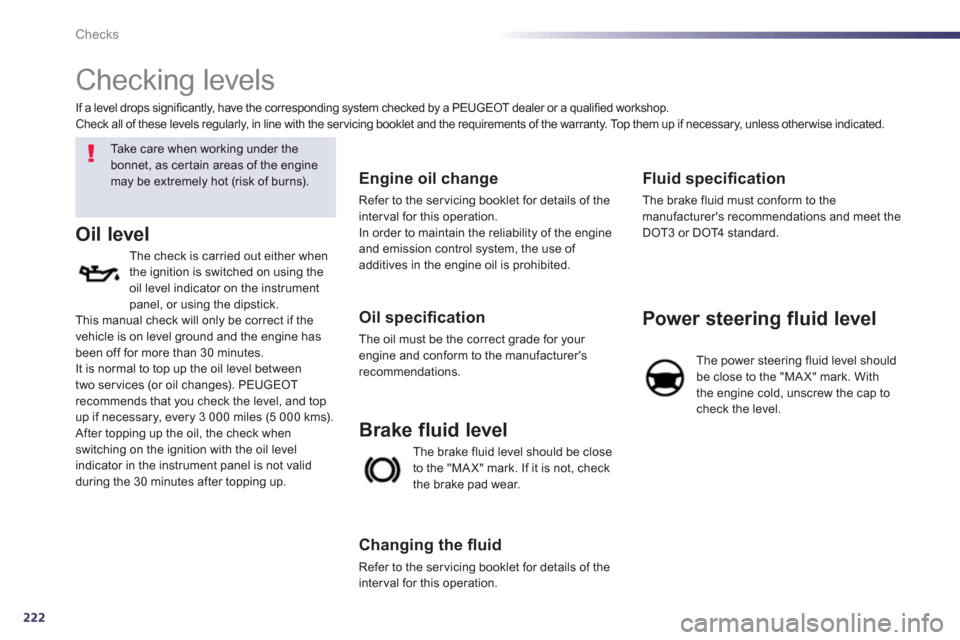Page 212 of 340

210
Practical information
General
recommendations
Observe the legislation in force in your country.Ensure that the weight of the towing vehicle is higher than that of the towedvehicle.The person at the wheel of the towedvehicle must have a valid driving licence.When towing a vehicle with all four wheels on the ground, always use an approved towing bar; rope and straps are prohibited. When towing a vehicle with the engine off, there is no longer any power assistance for braking or steering.In the following cases, you must always call on a professional recovery service:- vehicle broken down on a motor wayor fast road,
- 4 wheel drive vehicle, - when it is not possible to put the gearbox into neutral, unlock thesteering, or release the parkingbrake, - towing with only two wheels on theground, - where there is no approved towing bar available...
To w i ng from the rear
�)On the rear bumper, unclip the cover by pressing at the bottom. �)Screw the towing eye in fully. �)Install the towing bar.�)Switch on the hazard warning lamps on the
towed vehicle.
Page 221 of 340
9
219
Checks
The various caps and covers allow access for checking the levels of the various fluids and for
replacing cer tain components.
Petrol engines
1.
Power steering reservoir.2.Screenwash and headlamp wash reservoir.3.Coolant reservoir.4.
Brake fluid reservoir.
5. Battery / Fuses.
6.Fusebox.
7. Air filter.8.Engine oil dipstick.9.
Engine oil filler cap.
1.6 litre 16V VTi 120 hp
1.6 litre 16V THP 155 hp
Page 222 of 340
220
Checks
checking the levels of the various fluids, for replacing cer tain components and for primingthe fuel system.
*
Accordin
g to engine.
Diesel engines
1.
Power steering reservoir.2.
Screenwash and headlamp wash reservoir.3.
Coolant reservoir. 4.
Brake fluid reservoir.5.
Battery / Fuses.
6.Fusebox.
7. Air filter.8.Engine oil dipstick. 9.
Engine oil filler cap.10.Priming pump * . 11.
Bleed screw *
. 1.6 litre HDi 110 hp
2.0 litre HDi 140 hp
Page 223 of 340
9
221
Checks
The various caps and covers allow access for checking the levels of the various fluids, for
replacing cer tain components and for primingthe fuel system.
*
According to engine.
Diesel engines
1.
Power steering reservoir.2.Screenwash and headlamp wash reservoir.3.Coolant reservoir.4.
Brake fluid reservoir.
5. Battery / Fuses.
6.Fusebox.
7. Air filter.8.Engine oil dipstick.9.
Engine oil filler cap.10.Priming pump * . 11.
Bleed screw *
. 2.0 litre HDi 163 hp
2.2 litre HDi 200 hp
Page 224 of 340

222
Checks
Checking levels
Ta k e c a r e w h e n w o r k i ng under the
bonnet, as certain areas of the enginemay be extremely hot (risk of burns).
Oil level
The check is carried out either when
the ignition is switched on using the oil level indicator on the instrument panel, or using the dipstick.
This manual check will only be correct if the
vehicle is on level ground and the engine has
been o
ff for more than 30 minutes.
It is normal to top up the oil level between
two ser vices
(or oil changes). PEUGEOTrecommends that you check the level, and top
up if necessary, every 3 000 miles (5 000 kms).
After topping up the oil, the check whenswitching on the ignition with the oil levelindicator in the instrument panel is not validduring the 30 minutes after topping up.
Engine oil change
Refer to the ser vicing booklet for details of the
interval for this operation.
In order to maintain the reliability of the engine
and emission control system, the use of
additives in the engine oil is prohibited.
Oil specifi cation
The oil must be the correct grade for your engine and conform to the manufacturer'srecommendations.
Th
e brake fluid level should be close
to the "MA X" mark. If it is not, check
the brake pad wear.
Brake fluid level
Changing the fl uid
Refer to the ser vicing booklet for details of the
interval for this operation.
Fluid specifi cation
The brake fluid must conform to themanufacturer's recommendations and meet the
DOT3 or DOT4 standard.
Power steering fluid level
The power steering fluid level shouldbe close to the "MAX" mark. With
the engine cold, unscrew the cap to
check the level. I
f a level drops significantly, have the corresponding system checked by a PEUGEOT dealer or a qualified workshop. Check all of these levels regularly, in line with the ser vicing booklet and the requirements of the warranty. Top them up if necessary, unless other wise indicated.
Page 245 of 340
243
The system is protected in such a way that it will onlyoperate in your vehicle.
PEUGEOT CONNECT NAVIGATION (RT6)
01 First steps - Control panel
For safety reasons, the driver must carry out operations
which require prolonged attention while the vehicle is stationary.
When the en
gine is switched off and to prevent
discharging of the battery, the system switches off following the activation of the energy economy mode.
CONTENTS
02 Steering mounted controls
03 General operation
04 Navigation - Guidance
05 Traffic information
06 Using the telephone
07 Contacts - ADDR BOOK
08 Radio
09 Music media players
10 Audio settings
11 Configuration
12 Screen menu map p.
p.
p.
p.
p.
p.
p.
p.
p.
p.
p.
p.
244
246
247
249
263
266
274
277
2
80
2
86
287
2
88
Frequently asked questions p. 291
SATELLITE NAVIGATION SYSTEM
MULTIMEDIA BLUETOOTH TELEPHONE AUDIO
SYSTEM
Page 248 of 340
246
02STEERING MOUNTED CONTROLS
- Press: access to the instrumentpanel screen menu.
-
Rotation: navigation in the instrument panel screen menu.
- In
crease volume.
- Mute
/ restore sound.
-
Decrease volume. -
Rotation
Radio -automatic selection of next / previous frequency.
Media: previous / next track.
- Pr
ess then rotation: access to 6 preset stations.
-
Change the audio source.
- TEL/SRC button (short press):
Accept an incoming call .
Call in progress: access to telephone menu: hang up, secret pgpg
mode, hands-free mode.pgppg
- TEL/SRC button (long press): Reject an incoming call or end a call in progress. jj
When not making a call, accessto the telephone menu (Dial,g,g,
Contacts, Calls log, Voice p(p
mailbox). ,
- Select the type of permanent
display on the screen.
- Radio: displa
y the list of stations.
Media: displa
y the list of tracks.
Page 271 of 340
269
06USING THE TELEPHONE
Press this button.
Select " Dial" then confi rm.
Select " Directory of contacts" thenconfi rm.
Dial the telephone number using the
virtual ke
ypad selecting each number
in turn.
Con fi rm " OK " to make the call. Press this button or make lon
g press on
the steering mounted TEL/SRC button.
CALLING A NEW NUMBER
CALLING A CONTACT
Select the desired contact and con fi rm.
Select the number and con fi rm to start
the call.
MAKING A CALL Use of the telephone is not recommended while driving. Werecommended that you park safely or make use of the steering mounted controls.